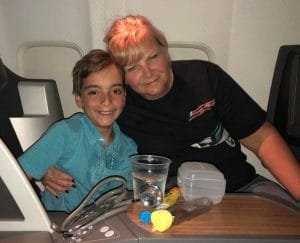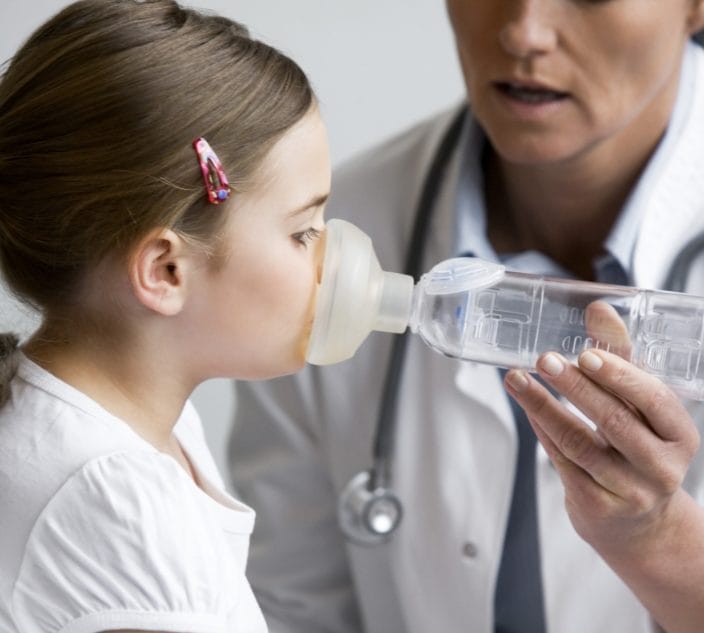 Photo: Getty
Photo: Getty Hopkins, a nurse, rushed from her seat and was soon attending to Luca, a 10-year-old from New York City, who had eaten one cashew. Though his mom, Francine Ingrassia, had never known her son to have a food allergy, Luca quickly began to experience chest pain, stomach pain and increased difficulty breathing.
Hopkins says it was clear to her that this was a severe allergic reaction. She told the crew on the flight from Aruba to Miami: “I need an EpiPen,” and they immediately made an announcement – asking anyone with an epinephrine auto-injector to step forward. Fortunately, two passengers volunteered to give the nurse their auto-injectors.
Airlines are not required to stock easy-to-use epinephrine auto-injectors, though a handful do now stock them. What is required in all airline medical kits are vials of epinephrine and syringes. I asked Hopkins whether the staff on this American Airlines flight appeared to know that epinephrine would be in the medical kit. She said this crew seemed unaware.
Hopkins has been reflecting on the incident, and the urgency with which she needed to administer epinephrine. Had she been forced to use a vial of epinephrine, the nurse from Missouri told me it would have presented several issues.
Extra Steps Consume Time
While she has had 10 years of experience as a critical care flight nurse, as well as being an ER nurse, Hopkins would have needed to look up the correct dosage for a child, then figure out the ratio of the saline dilution for the medication. There would be separate vials and different concentrations of epinephrine for cardiac versus allergic issues in the medical kit. So it would have been essential that she chose the right vial.
Our talk turned somber as Hopkins spoke about the rapid progression of Luca’s first reaction, during which the pilot considered an emergency landing. She felt the situation was life-threatening, and that the boy might not have made it if time-consuming extra steps had been required.
 Nurse Kellie Hopkins stepped in to give Luca an auto-injection during his in-flight emergency. Photo: Francine Ingrassia
Nurse Kellie Hopkins stepped in to give Luca an auto-injection during his in-flight emergency. Photo: Francine Ingrassia Four years earlier, Houston allergist Dr. Patricia Leonard found herself in a similar situation: called in to help with a child’s first-time anaphylactic reaction to cashew aboard a United Airlines’ transatlantic flight headed to Newark.
Leonard needed two doses of epinephrine to gain control of the 4-year-old girl’s symptoms and, on this flight, only a vial and syringe were available in the medical kit. She questions whether most medical professionals would know the dose of epinephrine to draw up for a child so young.
Dosing Gets Complicated
“The dosing for anaphylaxis in pediatrics is based on weight – not a completed calculation. It’s not a formula many physicians would be familiar with,” she told me. “When I was sharing the story with my [Houston] ENT & Allergy partners, one of them said: “I wouldn’t have a clue on the dosage to give a 4-year-old.”
I would be remiss not to bring up the occasional situation when there is no doctor or nurse on a flight. On my website, No Nut Traveler, one family reported a young child’s first reaction to nuts that resulted in an emergency landing. There was no physician on board and the crew felt unsure of the correct dosage for epinephrine to draw for a child.
It’s important to consider that anaphylaxis is on the rise. An analysis conducted by the Blue Cross Blue Shield Association reveals that emergency room visits by children due to anaphylaxis increased 150 percent from 2010 to 2016. It’s also not uncommon for children or adults to develop new allergies. In fact, studies have found that up to 25 percent of stock epinephrine auto-injectors (kept by U.S. schools for emergencies) are used to treat first-time reactions.
As well, a Northwestern University study found that adult-onset food allergies are increasingly common, with about 50 percent of people reporting they had developed their allergies after the age of 18.
So, in addition to a person with known food allergies needing epinephrine beyond their own device during a flight, the odds are reasonably high that someone may, like Luca, have a first-time reaction in the air.
Epinephrine Vials Can Be Tricky
When it comes to vials vs. auto-injectors in the medical kit, there are other issues. Leonard described struggling to read the tiny print of the form listing numerous drugs available and having to fumble around to locate the correct vial. As well, Vancouver allergist Dr. Donald Stark shared with Allergic Living that, a few years back, he cut his fingers on an epinephrine vial during an anaphylaxis emergency. “We got adrenaline [epinephrine] vials from the emergency kit while in some turbulent air. Trying to break open the top of a glass vial in order to draw up adrenaline is tricky,” he noted.
As food allergies rise in epic numbers, it’s also essential that airline crews be prepared for anaphylactic emergencies. In 2015, the former president of American Academy of Allergy, Asthma and Immunology (AAAAI) called for the addition of epinephrine auto-injectors to aircraft, with the recommendation for crew to be trained on the symptoms of a severe allergic reaction and how to administer auto-injectable epinephrine. Flight attendants are highly trained individuals, who can use a defibrillator. But they are seldom trained to use vials of epinephrine.
Those who board an airplane with known food allergies do not expect a risk-free flying space. But they usually do want to take precautions to mitigate the risk of having an in-flight reaction.
Importance of Pre-Boarding
Although preventing exposure is essential to allergy management, most airlines have a legal disclaimer saying travelers with food allergy are responsible for bringing medications. This falls short of the mark, as it is impossible to know what the previous traveler in your seat consumed. An important precaution for the allergic passenger is to pre-board in order to thoroughly clean any residue from their seat, tray and area. But many airlines don’t allow this simple step that can make a huge difference to avoid accidental ingestion.
The national food allergy organization FARE filed a complaint in 2017 with the U.S. Department of Transportation over an American Airlines’ policy that expressly forbids allergic passengers to pre-board to wipe down the seating area. “DOT is reviewing pending complaints against American Airlines for denying pre-boarding to travelers with food allergies in violation of the Air Carrier Access Act, and we look forward to their determination,” Mary Vargas, FARE’s attorney in the matter, recently told me. [UPDATE: As of December, 2018, AA will allow pre-boarding to those with nut or peanut allergies. Read more here.]
According to the Federal Aviation Administration, there are 2.6 million passengers flying on any given day. That means more people than ever in the skies with known or potential food allergies, thousands of miles from medical assistance.
In the 21st century, technology allows us to treat passengers with heart issues with a defibrillator (required on all U.S. airlines). In the same vein, we need to replace the inexact epinephrine vial and syringe with simple-to-use auto-injectors. Yes, there are costs, as there are with defibrillators, oxygen and any number of needed medical tools. As Hopkins noted, “If it was your child or parent or friend, wouldn’t you want this medical device to be available?”
Lianne Mandelbaum is the founder of No Nut Traveler.
Read more:
Allergic Living’s Airlines and Allergy Policies Directory
Fair Treatment in the Skies: Are Airlines Abusing Allergy Privacy?
Southwest Airlines Stops Serving Peanuts to ‘Welcome’ Peanut-Allergic





